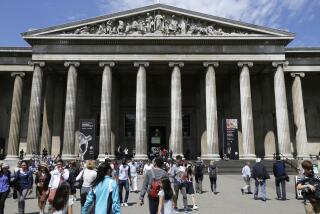Egyptian Curators Are Raiders of the Lost Art
CAIRO — Gaston Maspero, the first director of Egypt’s national storehouse of ancient treasures, is said to have believed his museum should resemble pharaohs’ tombs--crowded with paintings and statues, furniture and jewelry.
One hundred years after the Cairo Museum opened, its basement, at least, is everything the French Egyptologist could have envisioned. Wandering through its shadowy maze is like exploring the insides of a pyramid.
A flashlight’s beam picks out a 3-foot-long, bearded stone bust of a pharaoh resembling those at Luxor and Karnak that date back some 4,600 years. Elsewhere, a trio of cupids straight out of a Victorian cemetery form an incongruous honor guard for a dark stone Pharaonic figure in the familiar pose--arms straight at the sides, left foot forward, face imperious. A corner devoted to stone pedestals and capitals could be a spare-parts shop for a classical architect.
For the most part, the basement is off limits to all but museum staff and researchers. An Associated Press reporter was recently allowed a rare visit. Once inside, it is something of an Indiana Jones fantasy, minus the snakes.
The first stop in the main chamber is an area cleared to store the 150 or so items of “Hidden Treasures of the Egyptian Museum,” an exhibit set to open Dec. 9 to showcase objects long hidden in the basement and other storage sites.
The “Hidden Treasures” include two sphinxes the size of beagles, one headless, standing chest to chest on the cement floor under cowls of bubble wrap. On shelves behind sheets of clear plastic are a graceful, shallow stone vessel marbled in gray and charcoal, and delicately detailed funerary statues of workers doing tasks for the royal dead--offering beer, grinding grain. They haven’t been dated yet but resemble those found in the tomb of Tutankhamen, who ruled more than 3,300 years ago.
For years, museum curator Elham Salah had seen the basement as merely a place for leftovers. Then came an order from the irrepressible Zahi Hawass, director of the Supreme Council of Antiquities, to choose items for “Hidden Treasures.” That opened her eyes.
“It was a discovery,” she says. “We conducted an excavation inside the basement itself.”
Many of the basement treasures are tagged, though dust and time have obscured some information. Pieces from the museum’s holdings are cataloged, but the basement also has become the resting place for items from excavations and overflow from other museums for which there’s no central registry. Until planned cataloging of the entire basement begins in earnest, it will be difficult to determine how complete the basement records are, and how many pieces may remain mysteries forever.
Hawass estimates the basement holds some 100,000 items, about as many as in the galleries above that are open to the public. He has ordered every basement piece cleaned, cataloged and eventually transferred to new storage quarters to be built next to the museum.
More to Read
Sign up for Essential California
The most important California stories and recommendations in your inbox every morning.
You may occasionally receive promotional content from the Los Angeles Times.










